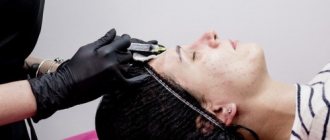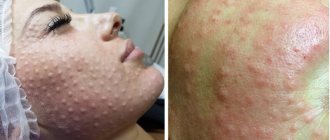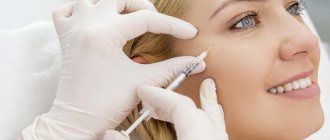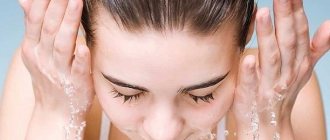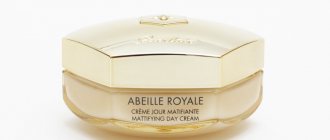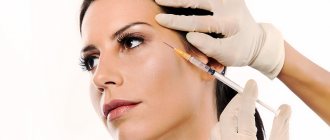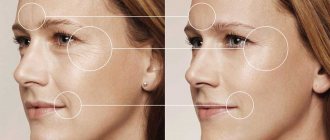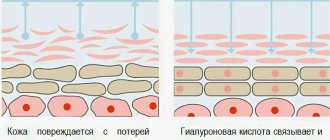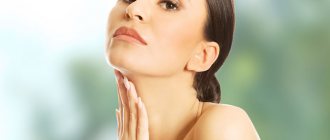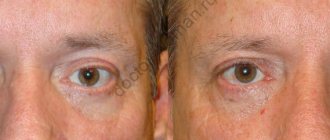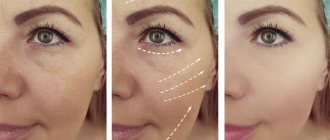The essence of the procedure
Biorevitalization is a cosmetic procedure that involves the injection of hyaluronic acid under the skin. Hyaluronate is the main component of our skin, ensuring its elasticity and hydration.
After 25-28 years, the skin begins to age and the amount of hyaluronic acid decreases noticeably. Biorevitalization with medicinal preparations helps replenish moisture and increase the turgor of the dermis.
Beauty injections contain hyaluronate, vitamins, microelements, peptides, signaling molecules and growth factors. The chemical structure of the cocktails is similar to natural hyaluronic acid produced by the body.
Care after hyaluronic acid injections
Hyaluronic acid injections are one of the most effective methods of skin rejuvenation. The introduction of preparations based on hyaluronic acid helps to rid the skin of signs of age, as well as improve its health, make it smooth and radiant.
Immediately after the procedure, a rehabilitation period begins, during which the skin will require special care to promote rapid healing and prevent infection of wounds. In addition, you will need to avoid anything that will promote rapid resorption and removal of hyaluronic acid from tissues.
Immediately after the injections, injection marks, papules, bruises and slight swelling are visible on the skin.
Papules on the skin can last from several hours to several days (depending on the drug used). Papules disappear on their own.
During the first 1-2 days, it is necessary to treat the wounds twice a day with an antiseptic that does not contain alcohol (Miramistin).
Active exposure to the skin increases swelling and promotes absorption of the drug. Therefore, you should not touch your face with your hands, much less massage it. Also, at this time, you cannot apply decorative cosmetics to the skin and, accordingly, remove them. You can use cosmetics 2-3 days after the procedure.
For the first two days, you should not expose your skin to high temperatures. In other words, you need to avoid hot baths, saunas, solariums, and blow-drying your hair. You should also refrain from cooking food to avoid hot air coming from the stove. You should wash your face very carefully with cool or slightly warm water. The shower shouldn't be hot either. You can wash your hair only 2-3 days after the procedure, being careful not to get soapy water on your face.
You should avoid physical activity for a week.
There are some dietary restrictions during this time. Products that promote fluid retention in the body are prohibited. These include all salty and spicy dishes.
For at least 5 days, but preferably 2 weeks, you should refrain from drinking any alcohol, as it interferes with the action of hyaluronic acid and contributes to the occurrence of edema.
You should consult your doctor about taking any medications.
At first glance, it may seem that the list of restrictions is quite extensive. However, it is not that burdensome. In any case, the health and beauty of our skin deserves careful attention.
Make an appointment for a consultation by phone: +375(29)168 22 88
You might be interested in:
- Hyaluronic acid injections;
- Reinforcement of the face with mesothreads;
- Reviews about biorevitalization.
Contraindications for biorevitalization
You should refrain from the procedure if there are several contraindications:
- chronic skin diseases;
- skin inflammation in the correction area;
- severe form of chronic systemic pathologies;
- period of pregnancy and lactation;
- allergic intolerance to administered biological products;
- autoimmune diseases;
- taking anticoagulant drugs;
- increased tendency to keloid scarring of the skin;
- acute herpetic infection.
It is also not recommended to carry out biorevitalization in the first phase of the menstrual cycle and during menstruation, due to changes in the pain threshold of sensitivity, the risk of bruising and swelling.
Why can’t you play sports immediately after biorevitalization?
Biorevitalization is a procedure aimed at rejuvenating the skin and improving its appearance. It exerts its effect through the introduction of a cocktail into the upper or middle layers of the dermis, where each molecule finds its place in the tissue and, spreading, smoothly and simultaneously restores all areas.
Sports after biorevitalization are included in the list of prohibitions issued by cosmetologists after exposure, and among the reasons that may interfere with the proper restoration of the skin, the following are particularly highlighted:
- All physical exercises activate metabolism and increase blood circulation. Because of this, the body is able to cleanse itself much faster of various wastes and toxins, which are excreted along with sweat. Hyaluronic acid, the main component of most injection formulations, can be removed with biological fluid in the same way as harmful elements, if it has not yet “dispersed” enough inside the integument.
- Due to increased blood flow to the face into which the drug was injected, traces of injections given during the session may appear. Moreover, sweating can disrupt the process of restoring the integrity of the skin, since drops of sweat have an irritating effect on damaged areas.
- Swelling will also inevitably appear with increased physical activity. This is due to the main property of hyaluronic acid: the structure of its molecules is capable of binding and retaining water, which is what the rejuvenating effect is based on. The acceleration of blood flow through the veins and arteries will lead to the fact that water will stagnate in the skin of the face, saturated with blood, which will lead to the appearance of bags under the eyes and a feeling of “narrowness” of the eyes.
- Hyperpigmentation is one of the side effects of playing sports after facial biorevitalization. This consequence may come as a surprise to those who prefer active outdoor exercise in the spring and summer. Ultraviolet exposure to areas of the face damaged by needles can cause uneven tanning or age spots, which can only be eliminated through other cosmetic procedures.
All of the above rules are completely simple to follow, but their clear and conscious implementation can preserve beauty and health for a longer time.
We recommend reading about what preparation should be for biorevitalization. From the article you will learn about general recommendations for preparing for the procedure, features of facial cleansing before biorevitalization. And here is more information about whether it is permissible to do peeling before biorevitalization.
What are the benefits of biorevitalization in summer?
In summer, our skin needs additional hydration, and biorevitalization helps solve the problem of dryness and protect against UV rays.
The advantages of biorevitalization in summer are as follows:
- safety and hypoallergenic;
- the ability to perform in various areas of the body (on the face, neck, abdomen, arms, knees, décolleté);
- reduction of skin hyperpigmentation;
- fast recovery period;
- obtaining long-lasting and lasting results.
Therefore, the answer to the question is whether it is worth doing biorevitalization in the summer, of course, yes.
Biorevitalization and tanning
First, you need to contact a qualified cosmetologist who will assess the condition of the skin and tell you about the rules for preparing and caring for the skin after the biorevitalization procedure.
During the procedure, the skin is cleaned and local anesthesia is administered. Next, hyaluronic acid or any other beneficial vitamins and minerals are injected into problem areas using injections. Of course, after the procedure there are microcracks in the skin that need time to heal completely. That is why solarium is contraindicated after biorevitalization. Otherwise, there is a high risk of sunburn, scars and age spots on the treated areas of the skin after biorevitalization.
Contraindications can be absolute or relative.
In the first case, you will have to abandon biorevitalization until complete recovery. If the contraindication is relative, then after consultation with the attending physician and his consent to the procedures, you can begin injections.
It is undesirable to carry out the procedure during menstruation: at this time, blood clotting decreases, and the likelihood of bruising increases.
Hyaluronic acid rarely causes intolerance, but this possibility cannot be ruled out. In addition, an allergy to other components of the drugs is possible.
If you have ever undergone biorevitalization, be sure to tell the doctor what drug was used and what the reaction was to it. This will help you make the right choice of biorevitalizant.
What is biorevitalization?
Biorevitalization is one of the most effective methods for correcting cosmetic skin defects, improving skin condition, and is also an effective way to slow down the appearance of signs of aging. In addition to its high efficiency, biorevitalization has a high level of safety, so its popularity is rapidly growing.
The procedure is carried out in 2 ways: by introducing microinjections into problem areas and saturating cells using a laser device. Invasive cosmetology is not inferior to a laser procedure and is widely used and is the fastest and virtually painless way to skin correction.
Contraindications
Since biorevitalization refers to medical cosmetology, we should not forget about possible contraindications for its implementation. In most cases, contraindications relate only to the injection procedure.
Before injection, each specialist can inform in detail about possible contraindications for use, even despite the fact that this procedure is considered one of the safest in cosmetology.
In particular, we should not forget about the individual characteristics of the body, which are not taken into account when compiling a general set of contraindications.
- Do not puncture in inflamed areas of the skin.
- Moles and other pigmented formations are prohibited from being pierced with a needle.
- The procedure is contraindicated in case of individual intolerance to the drug by the body.
- Not recommended for pregnant and lactating women.
- Malignant tumors are a direct contraindication to the use of this procedure.
What is hyaluronic biorevitalization of the face?
The beauty salon offers various procedures for skin restoration and rejuvenation. This can be mesotherapy, chemical and enzymatic peeling and much more. In addition, biorevitalization has become very popular today. What is the technique and why is it needed?
This is the intradermal injection of a hyaluronic acid substance into certain points, for which a syringe is used - a special injection device that makes manipulations less painful and more precise, and the distribution of the substance is uniform. In addition, stimulation factors can be used. Ultrasound, laser, current, cold exposure, magnetic waves, etc. are used as the latter.
But the main active component in all cases remains hyaluronic acid, which binds moisture, ensuring the desired arrangement of chains of protein molecules in the skin, which are known as elastin and collagen fibers. After the procedures, there is a noticeable improvement in the epidermis, and a pronounced rejuvenation effect.
Cosmetological techniques that can make the skin younger and more beautiful are becoming increasingly in demand.
What are these miracles of modern cosmetology? What effect will be after the procedures?
To begin with, it makes sense to examine the term “biorevitalization” itself, which has roots in Latin and is translated as “return to life.” “Bio” means “natural”, “re” means return, “vita” means “life”.
Isn't that what we want when we try to turn back time by any means possible? The beauty industry offers women an original, reliable solution to not only stop time and ensure high-quality prevention of skin changes associated with aging, but also get rid of existing wrinkles and defects, restore radiance, tone, firmness and elasticity.
Summer dangers
By the beginning of autumn, what often looks at us from the mirror is not a rested, full of energy person, but a tired, dull face, covered with wrinkles, age spots on rough, tight skin. It's not surprising! Under conditions of increased mechanical and thermal influence, the resources of the epidermis are depleted, and we, in pursuit of positive emotions and good mood, not only do not remember to do plasma lifting, but also forget about basic care products.
Several cosmetic procedures can solve the problem at once, and one of them is biorevitalization. The worldwide popularity of this injection rejuvenation technique is due to excellent results, absence of side effects, minimal rehabilitation period and ease of implementation. The latter especially appeals to busy people who have returned to everyday worries after a summer vacation.
How relevant is this after summer?
With the onset of autumn, metabolic processes in the body slow down, and if you do not pay due attention to this, the situation may worsen. Therefore, cosmetologists recommend taking a biorevitalization course after a summer vacation to help the skin rejuvenate and make it work. To obtain a lasting effect, 2-3 sessions with an interval of 2-3 weeks are enough, and the effect will last until next summer.
The procedure is painless and does not cause discomfort. And if you go to a reliable clinic, it will also be absolutely safe. If you are planning a course of rejuvenation with hyaluronic acid, then you can’t think of a better time of year than autumn!
After administration of biorevitalizant:
- skin renewal occurs - due to stimulation of metabolic processes in the dermis and the creation of new collagens and elastins;
- the skin is moisturized because hyaluronic acid is able to attract and retain moisture;
- wrinkles are smoothed out by maintaining the internal volume of the dermis;
- the overall appearance of the skin improves - it acquires a healthy complexion and natural radiance;
- a feeling of comfort and velvety appears - instead of the unpleasant feelings of dryness and tightness.
Indications for biorevitalization
If you want your skin to glow with youth and freshness, to be soft, smooth, as if glowing from within, biorevitalization will be an excellent choice.
As a result of exposure:
- Deep hydration of the dermis occurs;
- The skin is smoothed;
- The feeling of tightness disappears;
- Small wrinkles disappear, the relief is evened out;
- The complexion becomes more even;
- The epidermis becomes denser;
- The functioning of the sebaceous glands is normalized;
- The skin becomes firmer and more elastic.
Having realistic expectations will help you avoid disappointment. Biorevitalization will not help remove deep wrinkles, change facial features or eliminate obvious defects such as scars. It will not replace a circular lift. This type of treatment is aimed at improving the quality of the skin, deeply moisturizing it and inhibiting the aging process.
Main indications:
- Dryness, dehydration;
- First signs of wilting;
- Small wrinkles;
- Spider veins;
- Dark circles under the eyes;
- Excessive activity of the sebaceous glands;
- Decreased turgor;
- Dull shade;
- Rehabilitation after exposure to ultraviolet radiation, aggressive cosmetic procedures, and surgical interventions.
Contraindications
Cosmetic injection procedures are not performed if:
- Pregnancy, lactation;
- Oncological diseases;
- Epilepsy, mental illness;
- Fever, any acute diseases, exacerbation of chronic diseases;
- Autoimmune diseases;
- Diabetes;
- Inflammation, rashes in the injection area;
- Tendency to form hypertrophic scars;
- Blood clotting disorders;
- Individual intolerance to drug components.
How often can the procedure be done?
This depends on the method of administration of the drug. When injected, the substance enters the layers of the dermis faster and is more active. The interval between sessions is 3-4 weeks. The optimal course is 3 procedures.
With the non-injection method, 3 to 4 sessions per month are required. The full course will take 8-10 procedures. Repeating is possible only after six months.
Often doing anti-aging procedures is dangerous: biorevitalization oversaturates the skin of the face, the epidermis no longer produces its own acid.
Specialists can improve their knowledge in the field of cosmetology and master current and in-demand working methods at CHTA courses.
Is it possible to sunbathe after the procedure?
After the biorevitalization procedure, sunbathing is prohibited until the upper layer of the epidermis is completely restored. There should be no open wounds, redness or swelling. Tanning after biorevitalization can lead to sunburn, poor wound healing, infection of the body through microcracks, and the appearance of malignant neoplasms. Only after the cosmetologist's permission can you sunbathe and do any other cosmetic procedures.
Why you can’t sunbathe after biorevitalization
Biorevitalization involves numerous injections of useful substances. Ultimately, microcracks appear on the skin, which are contraindicated under thermal or ultraviolet influence. Only after the wounds have completely healed can you perform other cosmetic procedures or sunbathe on the beach.
Also interesting: Solarium after mammoplasty, prohibitions, rehabilitation period, tanning rules
The biorevitalization procedure may involve the elimination of pigment spots and other defects on the skin using hyaluronic acid. Under the influence of ultraviolet radiation, the opposite happens. Skin cells quickly lose moisture, age and die in the form of various new growths. That is why thermal exposure is contraindicated after a cosmetic procedure.
In addition, the body can become infected through microcracks during tanning, leading to poor wound healing. The tan will lie unevenly with pigment spots or malignant neoplasms. Therefore, it is better to wait until the upper layer of the epidermis is completely restored, consult a cosmetologist, and only then go to the solarium.
When is it allowed to visit the sauna and solarium?
You can sunbathe in a solarium only after the upper layer of the epidermis has been completely restored after the biorevitalization procedure. Mostly, the recovery process can last from one to two weeks. It all depends on the individual characteristics of a particular organism and compliance with skin care rules. In addition, you can always consult a cosmetologist who will select the optimal time for tanning.
